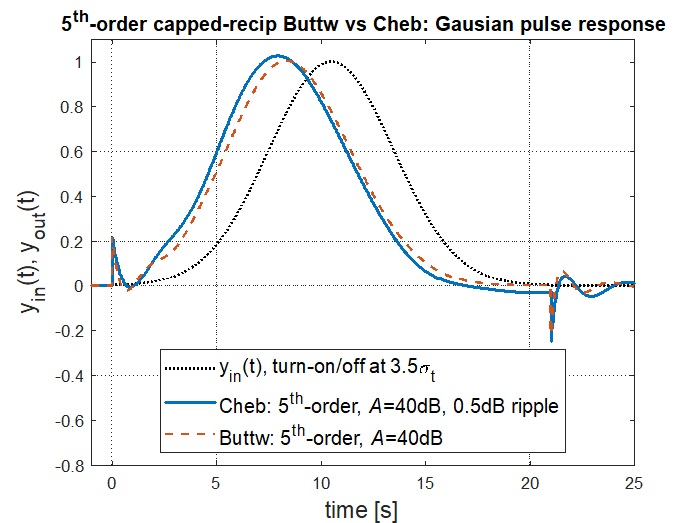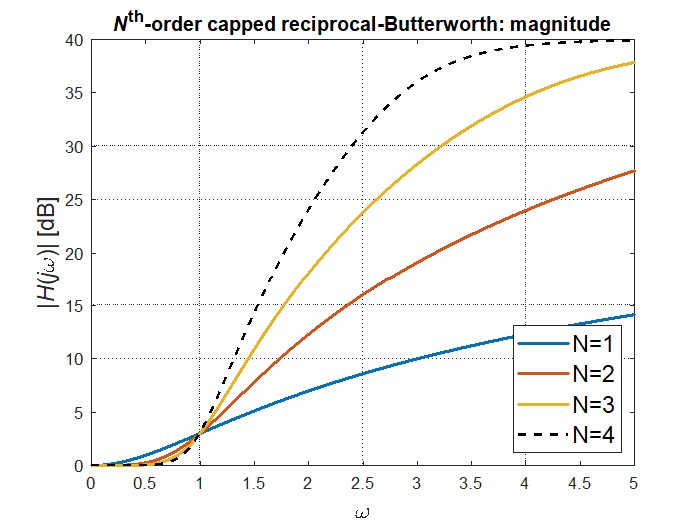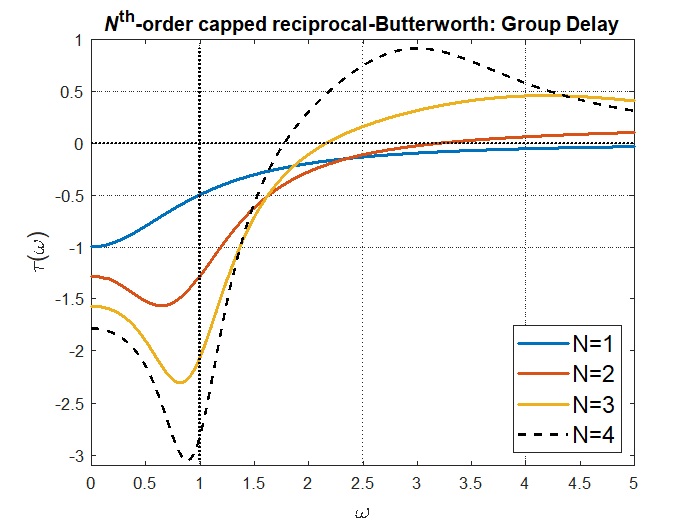


Negative Group Delay Filters -
NGD designs, trade-offs and optimization
Interpretation of Negative Group Delay (NGD) phenomenon in both the time and frequency domains, is demonstrated in the plots above.
The first plot is in the time-domain, for an input Gaussian pulse. The plot demonstrates the time-advancement of the output pulse peak relative to the input pulse peak (NGD effect) for two different NGD media (more details in the references at the bottom of the page). It also demostrates the effect of transients in the NGD output waveform, for pulses with defined turn-on/off times (an undesired trade-off of NGD, proportional to frequency domain out-of-band gain).
The second two plots show frequency domain magnitude and group delay (negative derivative of phase) characteristics of an NGD medium from a reference at the bottom of the page, based on a rational transfer function of order N.
In the time domain, the peak of an analytical pulse propagated through an NGD medium will appear at the output of the medium before it enters the input, given that the pulse frequency spectrum is mostly located within the NGD frequency band. This seemingly abnormal propagation does not violate causality, since the pulse turn-on and turn-off parts propagate normally, with a delay (at the speed of light or slower). It is only the steady state part of the pulse (for example a Gaussian pulse) that gets reshaped by the NGD medium in such manner that the pulse peak at the output precedes the input pulse peak.
Time-domain NGD trade-offs include:
- Amplitude of transients associated with turn-on and turn-off (tail) parts of the pulse
- Distortion of steady-state part of the pulse, due to reshaping
In the frequency domain, amplitude characteristic has its minimum at the center frequency, and phase characteristic has a postive slope within the NGD band (group delay, as a negative derivative of the phase characteristic, is therefore negative).
Frequency-domain NGD trade-offs include:
- Out-of-band gain (amplitude characteristic has a minimum at the center frequency), equivalent to time-domain pulse turn-on/off parts transient amplitudes
- Amplitude and/or phase distortion, equivalent to time-domain distortion of the pulse steady-state part
Optimized designs attempt to maximize the time-domain relative NGD (pulse advancement relative to pulse duration), or NGD-bandwidth product in the frequency domain, while keeping the above listed trade-offs below some predefined acceptable levels.
Applications of NGD filters and devices include:
- delay compensation (or even advancement) in signal transmission involving pulse waveforms
- beam-squint minimization in phased-array antennas, by the virtue of flattening the phase characteristic slopes
of delay lines between array elements, so the delay in electrical degrees is virtually constant for all frequencies
within the bandwidth
- wideband delay compensation in electromagnetic cloaking media
Several pertinent publications based (and expanding) on the work found in the Ph.D. thesis by Miodrag Kandic are listed below:
• M. Kandic and G.E. Bridges, "Maximally Flat Negative Group Delay Prototype Filter Based on Capped Reciprocal Transfer Function of Classical Bessel Filter", Progress in Electromagnetics Research (PIER B), 2025
• M. Kandic and G.E. Bridges, "Negative Group Delay Prototype Filter Based on the Ratio of Two Classical Chebyshev Filter Transfer Functions", Progress in Electromagnetics Research (PIER B), 2024
• M. Kandic and G.E. Bridges, "Negative Group Delay Prototype Filter Based on the Reciprocal Transfer Function of a Low-Pass Butterworth Filter Capped at Finite Out-of-Band Gain", Progress in Electromagnetics Research (PIER B), 2024
• M. Kandic and G.E. Bridges, "Negative Group Delay Prototype Filter Based on Cascaded Second Order Stages Implemented with Sallen-Key Topology", Progress in Electromagnetics Research (PIER B), 2021
• M. Kandic and G.E. Bridges, "Limits of Negative Group Delay Phenomenon in Linear Causal Media", Progress in Electromagnetics Research (PIER), 2013
• M. Kandic and G.E. Bridges, "Asymptotic Limits of Negative Group Delay in Active Resonator-Based Distributed Circuits", IEEE Transactions on Circuits and Systems I (TCAS), 2011
• M. Kandic and G.E. Bridges, "Bilateral Gain-Compensated Negative Group Delay Circuit", IEEE Microwave and Wireless Components Letters (MWCL), 2011
For any comments, questions or inquiries, you can email Miodrag Kandic by clicking here.
